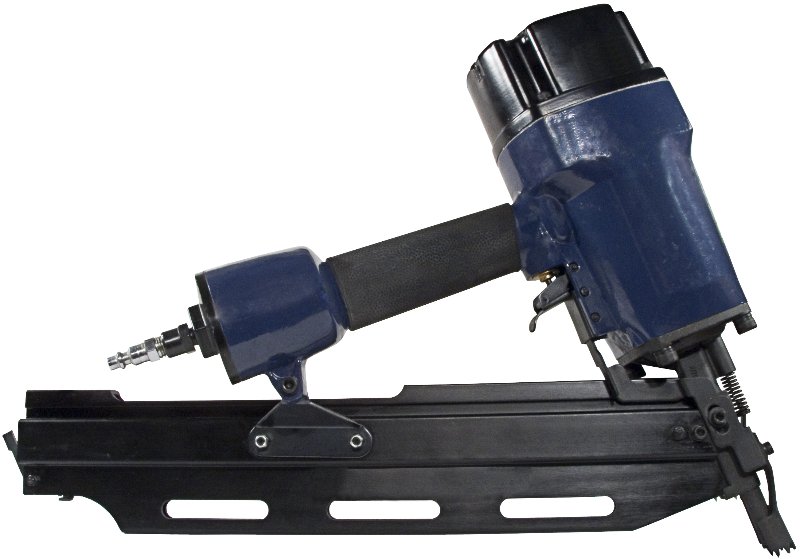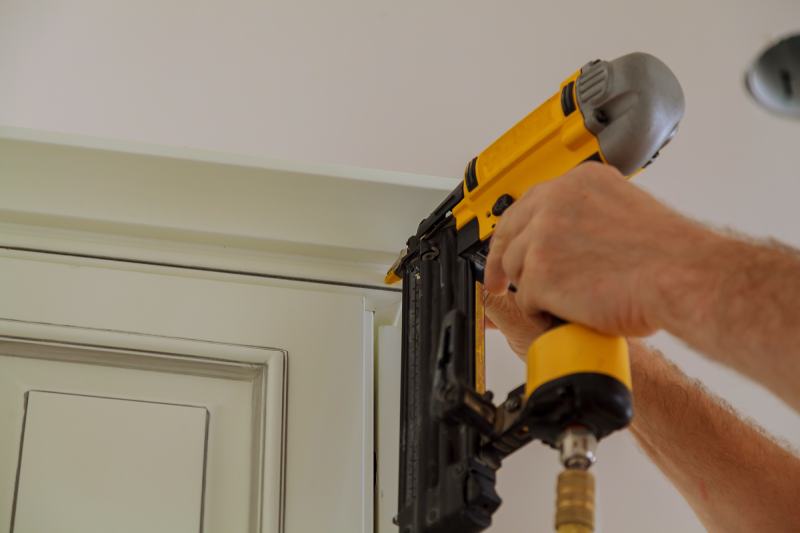21 vs. 30 Degree Framing Nailer: Pros, Cons, & Differences
-

- Last updated:

A nailer or nail gun is a form of a mechanical hammer that drives nails into a piece of wood, lumber, or wooden board. Nailers are useful in roofing, framing, insulation, and furniture making. Modern nailers are powerful, reliable, and safe to use.
The nail gun was invented by Morris Pynoos in the 1940s. Pynoos was an aircraft engineer working on Howard Hughes’ H-4 Hercules, a flying behemoth commonly referred to as the “Spruce Goose.” The aircraft was primarily made of wood, so there was a need for a mechanical hammer.
Today, there are many types of hammers fit for various roles. This article will compare two of the most common nailers—21 and 30-degree nailers—and help you find the best option.

Overview of the 21-Degree Framing Nailer
A 21-degree framing nailer is a unique gun made for heavier, thicker nails. The 21-degree framing nailer derives its name from the magazine’s angle. Depending on the manufacturer, the nailer magazine angle may range from 20 to 22 degrees. A three-degree variance typically gives the customer some latitude in choosing their angle.
This framing nailer can contain about 60 to 70 nails and the smaller magazine angle allows for seamless access to confined spaces.
Unlike most typical nailers that can only drive nails up to 2.5 inches, the 21-inch framing nailer can handle nails up to 3.5 inches.

What Is the 21-Degree Framing Nailer Good For?
The 21-degree framing nailer is ideal for use where a stronger hold is needed, such as in framing projects or other construction applications where thicker and harder lumber is involved.
Despite being heavier than a conventional nailer, this type of framing nailer is a must-have tool for anyone who works with timber—all thanks to its increased capacity and power.
Pros & Cons of the 21-Degree Nailer
- Powerful
- Easier to maneuver in confined spaces
- Can be used with various nail types
- Heavy
- Expensive

Overview of the 30-Degree Framing Nailer
This framing nailer’s angle ranges between 30 and 34 degrees. With this greater angle, they offer the best access to narrow areas in framing.
The collation for a 30-degree framing nailer is a paper strip, with most nail magazines made to contain two strips of nails in order to minimize loading. Paper strip nails are less messy and simpler to store than plastic collations; however, they are more likely to break if exposed to dampness.
Another great feature of the 30-degree framing nailer is its ability to work with a variety of nails. This implies that you can choose the appropriate nail for your project regardless of whether you are using softwood or hardwood. This nailer also has the capability to drive nails from 2–3.25 inches.
Lastly, the enhanced balance and ergonomics offer a smooth feel and less fatigue while adding control and comfort.

What Is the 30-Degree Framing Nailer Good For?
You can use the 30-degree framing nailer for a variety of applications, such as subflooring, sheathing, and framing. When used for framing, it can go a long way to strengthen and stabilize the joints.
The powerful force it exerts on nails allows it to use longer nails for sheathing. It also ensures your sheathing is well secured because sheathing applications need nails that are somewhat lengthier than the ones used for framing.
If you have multiple projects and need a nailer that can handle them, then the 30-degree nailer is your best shot.
Pros & Cons of the 30-Degree Framing Nailer
- It can be used with coil and standard nails
- Lighter than 21-degree nailers
- Less compact, making it challenging to maneuver in constricted spaces
- Less powerful than a 21-degree framing nailer

Types of Framing Nailers
There are various types of framing nailers classified according to the primary source of power.
1. Pneumatic Framing Nailers
A pneumatic nail gun is a type of framing nailer that uses compressed air from a compressor to generate the force needed to propel the nail into the wood. They are lighter than electric nailers because they use air and their source of power is independent of the nailer itself. Also, they have greater power and deliver quicker shots than their equivalents. According to experts, the speed of a hose-connected pneumatic nailer can reach over 1,400 feet per second and can fire up to 9 nails per second.
If not accompanied by an air compressor, the pneumatic nailer will be equipped with a detachable cylinder. The cylinder is small and requires frequent refills to have the air pressure required for nailing.
2. Electric Framing Nailers

As the name suggests, electric framing nailers generate mechanical force using batteries or power from 110/240V sockets. Its working mechanism is very simple—electric energy rotates motors to drive the hammer. The hammer, in turn, pounds on the nail to drive it down.
Another type of electric framing nailer uses motors to compress a spring and release it suddenly after reaching a certain point. As it springs back, the restoring force hits the nail.
Even though they are less powerful than pneumatic nailers, electric nail guns are still useful for DIYers. They are easy to repair and common in many garages. Unfortunately, battery-powered guns are heavier, and the battery requires frequent charging, depending on how often you use it.
3. Fuel Cell or Combustion Nailers
Although they are less prevalent, fuel-powered framing nailers are still popular. They depend on the combination of a rechargeable battery and fuel cell for power. It works by igniting the flammable gas from the fuel cell using sparks produced by the battery. This causes a small explosion that rotates the piston to push the nail from the strip into the lumber.
Compared to a cordless model, fuel-powered nailers are often light in weight and will last longer before recharging or replacing the battery and fuel.

What Are the Main Differences Between a 21 And 30-Degree Framing Nailer?
The main difference between these two types of nailers lies in the angle of collation and the corresponding magazine angles. Unlike the 21-degree framing nailer, the 30-degree angle allows you to use the nailer at constricted spots. The magazine angles also play a critical role in terms of how nails are inserted into the tool.
The 21-degree framing magazine can contain two strips of nails totaling about 60 framing nails, while the 30-degree nailer can accommodate up to 88 nails. It can hold offset nails or clipped head nails, so you can use a wide variety of nail types. This makes the 30-degree framing nailer a more versatile tool for numerous projects.
Another significant distinction lies in the amount of power generated. A 21-degree framing nailer has more power than its 30-degree counterparts, making them better suited for demanding tasks. On the downside, this also makes them a bit heavier to maneuver.
30-degree framing nailers are more versatile and better suited for small projects at home, while 21-degree nailers are ideal for construction projects.
For quick understanding, this comparison table sums everything up.
| 21-Degree Nailer | 30-Degree Nailer | |
| Nail collation angle | 20 to 22 degrees | 30 to 34 degrees |
| Nailhead | Full Round Head | Clipped head or offset head |
| Type of collation | Plastic | Paper |
| Nail length | 2 to 3 ½ inches | 2 to 3 ½ inches |

Conclusion
The choice will ultimately depend on the intended use. If you are searching for a strong nailer for harder tasks, the 21-degree nailer is your perfect choice. But if you want a more reasonably priced one that is still adaptable enough to tackle the majority of projects, a 30-degree nailer might be a better alternative.
Featured Image Credit: (L) – 21° Framing Nailer (gun_brizmaker, Shutterstock) | (R) – 30° Framing Nailer (Tyler Olson, Shutterstock)
Contents
